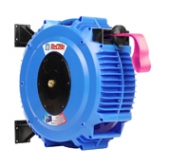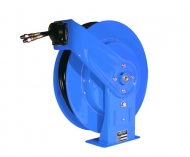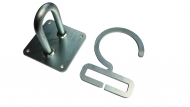No Entry: Cordon off hazardous areas with a barrier reel
Friday, 17 February 2012 23:40Many workplaces have areas that are designated for both thoroughfare and restricted access at different times. An example would be a warehouse roller door – deliveries need to come in and stock needs to go out, but customers and visitors need to be made aware of ‘No Entry’ rules.
Traditionally, businesses have used traffic cones, bollards, wall mounted signage, free standing signs or a combination of these methods to deter customers, visitors or unauthorized staff. When access needs to be made available multiple times a day, bollards and similar barrier methods become cumbersome to move and are sometimes not put back in place by staff, and in the case with wall signage, are occasionally not seen at all.
ReCoila manufactures an easy solution for areas that are designated as both thoroughfare and restricted access – a wall mounted safety barrier reel, fitted with 15 metres of retractable barrier tape, in high visibility orange, pink or yellow. A model is also available fitted with yellow plastic chain.
When mounted on the side wall of a doorway or access way, the BAR Series reels allow staff to easily unwind up to fifteen metres of chain or tape and attach it to a hook on the opposite wall. The barrier is quickly and easily retracted when pedestrian or vehicular access is necessary.
The reels have a durable impact and UV resistant outer case coupled with a heavy duty spring mechanism, making them ideal for harsh industrial environments.
7 ways to extend the life of industrial hoses
Saturday, 04 August 2012 00:51Hoses are common place throughout industry, providing a practical and effective method for conveying or transferring liquids and gases.
External factors found in the working environment can have an adverse effect on the hose considerably reducing its life span – factors such as extreme temperatures, humidity, sunlight, oils, solvents, surfactants, welding spatter, corrosive atmosphere or exposure to aggressive chemicals.
Although industrial hoses are generally considered a consumable item and will need replacing from time to time, properly managing, using and storing hoses will help reduce and in some cases prevent premature failure, and will in most cases increase their perceived life expectancy which in turn reduces high maintenance costs.
Some common workplace scenarios:
- Hoses in factories are run over by forklifts or other machinery – this compromises the support structure within the hose
- Hoses are bent and twisted into tight spots and develop kinks and bends – effecting the integrity of the hose
- Hoses are left laying around or are dragged around a warehouse causing them to become damaged on abrasive floors and surfaces, damaging the outer protective layer
- Hoses are left laying in highly acidic or alkaline environments such as food prep areas, which effects the hose
- Hoses are contaminated by vegetable fats and animal fats – these attack and leach structural polymers and plasticisers from the hose
Hose failure leads to bigger issues
Some of the more serious effects of improperly managed hoses can include damaged equipment, forced machinery downtime, injuries such as trips and falls, and much more serious injuries if high pressures, chemicals or hazardous substances are involved.
Getting the most out of your hoses
Take note of these tips to maximise the effective service life of hoses in your workplace.
- Ensure the hose you are using is right for the job. Using the correct hose for your application is crucial to ensuring you get the longest life and best performance out of your hose.
- Know what substances found in the work environment are likely to damage your hose. Often hoses manufactured from a particular material have excellent resistance to some chemicals or substances, and not so good resistance to others. Your hose manufacturer can help you with the specs for your particular hose.
- Inspect hoses regularly. Check the hose before using it – if you have any concerns about its suitability for the task, quarantine the hose, let your supervisor know, and follow your workplace safety procedures.
- Be aware of the hose’s natural bend radius. The bend radius is the minimum radius that a hose or cable can bend without kinking – your hose manufacturer can help you with this specification. If a hose is bent or twisted past its natural bend radius, the inner layers can be compromised which can cause splitting and failure of the hose. And if a hose is bent close to the end fitting (as shown in the above photo), the hose barb can scratch or pierce the inner lining resulting in a damaged hose.
- Keep them away from extreme heat. Hoses that are used close to exhausts, motors and heat-emitting mechanical equipment may fail faster than those that are shielded from heat sources.
- Keep them out of the elements. Hose life can be maximised by storing hoses away from harsh sunlight in a clean, dry environment. Obviously, this isn’t always possible, especially in truck-mounted applications, however consider ways you might protect hoses that are used outside. Can a cover be installed? Could the hose be run along a different path that is more protected? Can the hose or hose reel be mounted inside a frame or box?
- Store hoses correctly. Hoses stored neatly up off the ground are likely to stay cleaner for longer, and are less likely to be damaged by vehicles and environmental factors. Using a hose reel can increase the life of hoses, as well as creating a safer, more productive working environment.
As always, it’s best to contact your hose manufacturer for further information on your particular type of hose.
What do you do to prolong hose life in your workplace?
Smooth Operator – Your Missing Link to Lubrication Success
Wednesday, 17 December 2014 02:27Lubrication is the lifeblood of modern industry. More than just a ‘machine additive’, lubricants are crucial to the safe, reliable, efficient functioning of all machinery.
Without proper and timely lubrication, even our most advanced workhorses of industry would succumb to the frictional stresses of wear, overheating and corrosion.
Machine bearings are particularly susceptible to haphazard lubrication procedures. According to leading industry journal Machinery Lubrication, up to 80 percent of all bearing failures are the result of improper lubrication, with considerable potential to trigger not only catastrophic machine failure, but full assembly-line stoppages.
Indeed, beyond the more obvious – and onerous – repair costs, the potential fallout from lubrication-related failure can prove crippling for the today’s businesses: from protracted downtime, to the more insidious consequences of functional failure (whereby machines consistently under perform specifications), and premature failure (a reduction in the operational lifecycle of machine parts), both serious hogties on long-term efficiency.
Yet despite the critical importance of lubrication to basic mechanical functions, it appears more and more that the once routine process of oiling and greasing has fallen by the wayside. Whether through improper lubricant selection, substandard application, or simple neglect of lubricant degradation, it’s clear that this essential maintenance procedure is being sidestepped or, even worse still, entirely overlooked.
So what’s triggered this dangerously lackadaisical approach to this essential maintenance process? While many would claim it is simply poor in-house processes, some industry experts have cast blame on the success of today’s predictive maintenance programs.
Indeed, so effective are these programs in rooting out and resolving equipment problems, ‘we [have],’ according to Machine Maintenance, ‘[lost] sight of the fact that many components are failing early because lubrication best practices (right lubricant, right time, right quantity, clean, dry and cool) have not been established.’
So in our increasingly automated world, how can we ensure the consistent and reliable application of manually applied lubricants that protect our machines of industry?
The Challenges of Modern Lubrication
Lubrication is a deceptively fine art. Too little lubricant, and internal mechanisms will be exposed to frictional wear; too much, and the lubricant’s base oil will rapidly churn, thicken and disintegrate, leaving little grease to effectively lubricate the bearing.
With a countless array of fittings and access points, the complexity of modern machinery presents its own difficulties for maintenance crews. Indeed, one of the chief obstacles to effective and consistent lubricant delivery is the difficulty posed in simply accessing the machine’s grease zerk nipples. As a result, what was once a simple greasing process has become cumbersome and time-consuming rigmarole.
What’s more, the physical demands of the lubrication process can prove a serious workplace hazard. Awkward positioning of grease fittings places maintenance workers at risk of severe grease injection injuries. The consequences of a high-pressure injection injury can be devastating: from tissue damage to potential loss of limb.
As such, the key to a successful lubrication regime is to incentivise maintenance crews with the tools, skills and know how to ensure consistent, accurate and safe delivery of lubricant.
5 Steps to Foolproof Machine Lubrication
1.Abide by the lubrication recommendations of the machine manufacturer, including quantity and type of lubricant (e.g. oil or grease-based, viscosity requirements etc.); avoid the temptation to over-lubricate bearings.
2.Be mindful of WHS requirements. Ensure workers can easily access grease ports: awkward positioning could induce high-pressure injection injuries and may affect the consistency and accuracy of lubricant delivery.
3. Keep an eye on machine gauges (such as temperature) for early indications of problems and under-lubrication; optimal operating temperatures for bearings are between 35 °C and 70 °C, though this can vary greatly depending on external environment.
4.Listen for noise or unusual machine vibrations.
5. Watch for any fluid leaks, which could indicate over-lubrication or other serious mechanical faults.
The Reel Link to Successful Lubricant Delivery
Achieving successful lubrication requires regular, precise and targeted lubricant application.
As one of the chief delivery mechanisms for machine lubricants, the hose line is the forgotten hero of the manual lubrication process. A quality industrial-grade lube hose is essential for the effective maintenance of both mobile and plant-based equipment, offering seamless access to the most hard-to-reach grease access ports.
Built to withstand the extreme pressures of oil or grease conveyance, industry-grade lubrication hoses offer maintenance crews superior handling and quantity control over lubricants for manual grease or oil top-up, critical to dispensing lubricant in a consistent, safe and precise manner.
Yet a lubrication hose cannot exist without a quality support reel.
Industrial-grade steel framed reels help to deliver convenience, protection and ergonomic support for a vast array of lubrication hoses.
Safety is at the forefront of today’s industrial hose and reel designs. These ultra-robust systems are specifically designed to with stand the environmental extremes of the plant floor, helping you meet stringent workplace health and safety requirements.
As Australia’s premier supplier, manufacturer and distributor of industrial-grade hose reels, ReCoila is dedicated to delivering superior quality hose reels for the most challenging industrial requirements.
ReCoila’s expertly engineered hose reels are built to deliver safe and measured conveyance of lubricant. These ultra-robust reels offer maximum ergonomic support throughout the lubrication maintenance processes, whilst supporting consistent, predicable and measured lubricant flow.
The loose hose line presents one of the more obvious ‘trip and slip’ hazards on the work site. A quality spring-retractable reel significantly reduces the risk of kinking, knotting or straying of hoses, eliminating this niggling work site hazard. With a gentle tug, these robust auto-rewind reels offer safe and secure storage for hose lines, markedly increasing their operational lifecycle.
With reliability, safety and quality at its core, ReCoila can recommend the best hose reel for your unique lubrication needs.
This article was produced in conjunction with Cirrus Media and was published in Manufacturers Monthly
Product update: barrier reels now available with hooks
Monday, 09 February 2015 02:43Safety barrier reels are perfect for cordoning off areas that are out of bounds for pedestrians, or flagging no-entry areas with a high visibility barrier. ReCoila's BAR Series barrier tape reels are now available fitted with 15 or 20 metres of fluoro pink, yellow or orange webbing.
NOW AVAILABLE: FIXING HOOKS FOR BARRIER REELS
A sturdy steel hook and clip set allows you to create a permanent fixing point for your barrier reel. Mount your reel to a wall, attach the hook to the end of the barrier tape, and mount the D plate on an opposite wall to make a fixing point.



